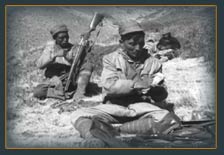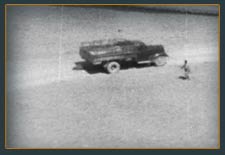|
|
 |


 
Page 1 - 2
BACKGROUND Page 2
 Throughout the sixties, the guerrillas launched raids into Tibet from their base in Nepal, attacking military convoys along the strategic Sinkiang-Tibet highway. On one occasion, they recovered military documents that provided Western intelligence with its first inkling of the failure of the Great Leap Forward in China.
Throughout the sixties, the guerrillas launched raids into Tibet from their base in Nepal, attacking military convoys along the strategic Sinkiang-Tibet highway. On one occasion, they recovered military documents that provided Western intelligence with its first inkling of the failure of the Great Leap Forward in China.
 As Chinese control over Tibet tightened and America's larger policies began to change, the CIA increasingly saw its Tibetan protégés as little more than an intelligence gathering unit and began to discourage them from making armed incursions inside Tibet. In 1969, the CIA abruptly announced to the resistance leaders that it would no longer support their movement and that all aid would be phased out over a three-year period. Shortly afterwards, in 1971, the US Secretary of State Henry Kissinger made his secret mission to China and set into motion the normalization of relations between the two countries. The Tibetans had simply fitted into America's larger policy of destabilizing or overthrowing Communist regimes and when that no longer applied to China, they were abandoned. As Chinese control over Tibet tightened and America's larger policies began to change, the CIA increasingly saw its Tibetan protégés as little more than an intelligence gathering unit and began to discourage them from making armed incursions inside Tibet. In 1969, the CIA abruptly announced to the resistance leaders that it would no longer support their movement and that all aid would be phased out over a three-year period. Shortly afterwards, in 1971, the US Secretary of State Henry Kissinger made his secret mission to China and set into motion the normalization of relations between the two countries. The Tibetans had simply fitted into America's larger policy of destabilizing or overthrowing Communist regimes and when that no longer applied to China, they were abandoned.
When orders finally came to withdraw, several of the CIA's field officers were caught by surprise as well. They never forgave their superiors for what they believed to be the betrayal of their Tibetan allies. These men still recall their involvement in Tibet with a mixture of pride and regret. recall their involvement in Tibet with a mixture of pride and regret.
The organization survived for a few more years but the end finally came in 1974 when the Nepalese Government, acting under pressure from China, sent in its army to close down the guerrilla base. As the Tibetans prepared for one final showdown, a taped message arrived from the Dalai Lama calling on them to surrender peacefully. One by one, grizzled veterans of the twenty-year campaign against the Chinese laid down their arms in tears; a few committed suicide rather than accept defeat. Tibet's armed struggle for independence had come to an ignominious close.

Previous Page | Return To Top
|



